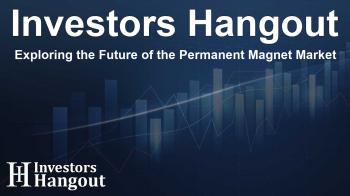Exploring the Future of the Permanent Magnet Market

The Future of the Permanent Magnet Market
The global permanent magnet market is anticipated to see remarkable growth, with projections suggesting it could reach a value of USD 88.51 billion by the year 2030. This growth represents an impressive increase from USD 58.87 billion observed in 2025, showcasing a compound annual growth rate (CAGR) of 8.5%.
Understanding Permanent Magnets
Permanent magnets are unique materials that produce a consistent magnetic field without the need for an external energy source. These magnets maintain their magnetism long after the removal of magnetic forces, a characteristic that makes them valuable in various applications. Typically composed of hard ferromagnetic materials, permanent magnets attract or repel other metal objects and magnets. As industries push for advanced technologies, the demand for high-performance magnets is expected to surge, particularly driven by environmental concerns and the growth of renewable energy solutions.
Key Growth Factors in the Market
One of the main drivers for the permanent magnet market is the increasing demand from the electric vehicle (EV) sector. The global transition towards EVs has generated a growing need for efficient and powerful magnets, particularly in electric motors. The versatility and effectiveness of Neodymium Iron Boron (NdFeB) magnets make them a dominant force in the market. These magnets combine high magnetic strength with excellent thermal performance, making them suitable for a range of applications, particularly within automotive technology.
Market Segmentation by Magnet Type
The permanent magnet market comprises several types, primarily segmented into Neodymium Iron Boron (NdFeB), Ferrite, Samarium Cobalt (SmCo), and Aluminum Nickel Cobalt (AlNiCo). As of 2024, NdFeB magnets are projected to hold the largest share of the market value. Their high performance at a lower cost positions them favorably in numerous applications, including hybrid vehicles where efficiency is paramount.
Manufacturing Processes Driving Demand
Manufacturing processes for permanent magnets are critical for meeting the evolving demands of various industries. The market is split into sintered and bonded magnet segments, with bonded magnets expected to be the fastest-growing category due to advantages like lightweight designs and the capacity for intricate shapes. These characteristics align perfectly with the industry's trends towards miniaturization and advanced technology.
Regional Insights
Geographically, the Asia-Pacific region is leading the charge in the permanent magnet market, both in terms of value and volume. Rapid urbanization and industrial growth are driving consumer spending significantly in this area. Additionally, the emphasis on sustainability is propelling the demand for permanent magnets across industries, as businesses shift to more eco-friendly and recyclable materials.
Impact of Government Initiatives
Governments in the Asia-Pacific region, especially India, are actively encouraging domestic production of rare earth magnets to reduce dependence on external supply. This initiative is reshaping market landscapes, as seen with major companies planning substantial investments in localized production facilities.
Leading Players in the Market
Prominent organizations in the permanent magnet industry include Proterial, Ltd., Arnold Magnetic Technologies, and TDK Corporation, among others. These players are leveraging innovative manufacturing processes and expanding their product lines to harness emerging market opportunities.
What's Next for the Permanent Magnet Market?
With growing applications in various sectors like consumer electronics, automotive, and renewable energy, the need for permanent magnets continues to expand. As manufacturers adapt to new technologies and consumer preferences, it is essential to keep an eye on market trends and player strategies to identify ongoing opportunities for growth and efficiency.
Frequently Asked Questions
What is the projected value of the permanent magnet market by 2030?
The permanent magnet market is projected to reach USD 88.51 billion by 2030.
What factors are driving the growth of the permanent magnet market?
The growth is largely driven by rising demand in electric vehicles and advancements in environmentally friendly technologies.
Which type of permanent magnet holds the largest market share?
Neodymium Iron Boron (NdFeB) magnets currently dominate the market due to their high performance and cost-effectiveness.
How is the manufacturing process impacting market trends?
Bonded magnets are the fastest-growing segment, providing design flexibility and the ability to produce complex shapes, which are essential in modern applications.
Which regions are leading in the permanent magnet market?
The Asia-Pacific region leads the market in both value and volume, thanks to industrialization and consumer trends towards sustainable solutions.
About The Author
Contact Ryan Hughes privately here. Or send an email with ATTN: Ryan Hughes as the subject to contact@investorshangout.com.
About Investors Hangout
Investors Hangout is a leading online stock forum for financial discussion and learning, offering a wide range of free tools and resources. It draws in traders of all levels, who exchange market knowledge, investigate trading tactics, and keep an eye on industry developments in real time. Featuring financial articles, stock message boards, quotes, charts, company profiles, and live news updates. Through cooperative learning and a wealth of informational resources, it helps users from novices creating their first portfolios to experts honing their techniques. Join Investors Hangout today: https://investorshangout.com/
The content of this article is based on factual, publicly available information and does not represent legal, financial, or investment advice. Investors Hangout does not offer financial advice, and the author is not a licensed financial advisor. Consult a qualified advisor before making any financial or investment decisions based on this article. This article should not be considered advice to purchase, sell, or hold any securities or other investments. If any of the material provided here is inaccurate, please contact us for corrections.

